An edition of 6 handmade portfolios comprising 26 photographs and an essay, Kate Mount’s ‘Twenty Six Achill Hearths’ collects the photographer’s images of hearths found in abandoned cottages on the Irish island of Achill, Co. Mayo — a place Kate first visited with her grandmother more than 60 years ago. Here Kate introduces the project, and talks to Kirsteen McNish about return, resurrection, and hearths as the heart of the house.
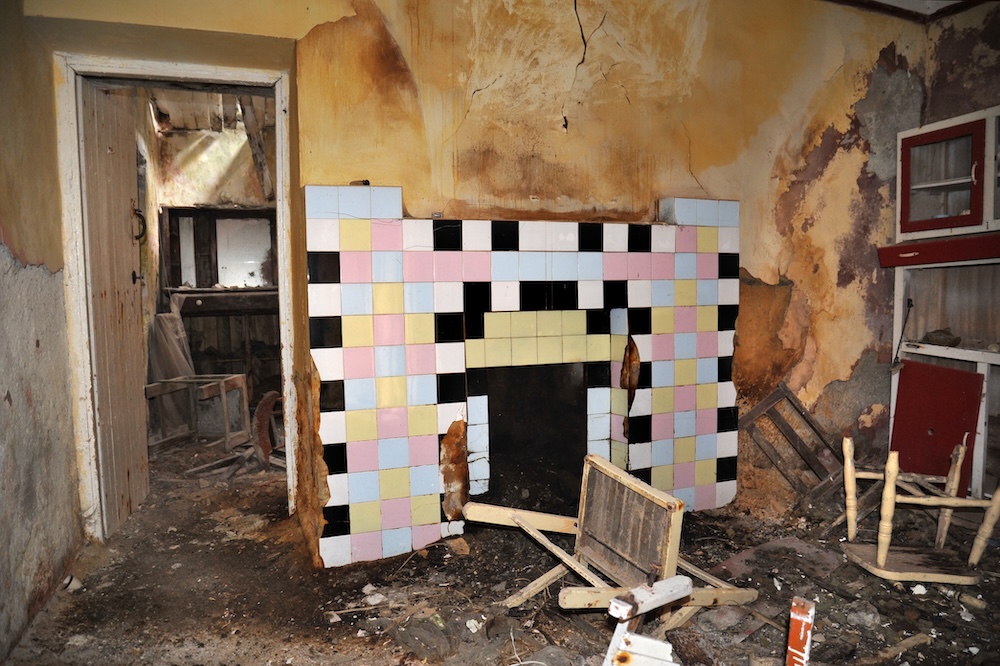
In 1960, a 10-year-old Kate Mount travelled across Ireland to Achill Island with her 80-year-old grandmother. This journey would become significantly etched in Mount’s consciousness. Returning to Achill as an adult has been a powerful experience for Mount and brought forth many powerful childhood memories — ones it seems that were not subsequently parentally “edited” or translated but entirely seen through Kate’s own eyes. Twenty Six Achill Hearths seems to be not just about return, but respect and resurrection — made more profound by the fact that there are only 6 hard copies of these affecting portfolios; hand made by Mount with the help of the Letterpress at Dartington Hall in Devon, where she now resides.
Kirsteen McNish: Tell us a bit more about Achill Island and what you know of its history?
Kate Mount: Achill Island is the largest of the Irish isles and lies off the west coast of County Mayo in the republic of Ireland. The landscape is rugged and wild with mountains, sea cliffs, peat bogs and long sandy beaches. It is attached to the mainland by a swing-bridge — the Michael Davitt Bridge, the first one was built in 1887. Roughly half the island is in the Gaeltacht (traditional Irish-speaking region) of Ireland.
For many years there has been a history of emigration from the island. Often the families would remain on the island while the man of the house would go over to England to work. My grandfather Peter Gallagher brought his whole family over to England to try and make a better life for them all.
Reading your introductory essay it feels instinctively like a very sensorial project, the smell of the turf, the condition of the houses in disrepair, the entering of the space gingerly as a young child, bearing witness to what these hearths represented to those that gathered around them. What does this project say about community and family? What can you remember about the economic and cultural situation of the time?
The whole project really stems from my visit with my 80-year-old grandmother, as a ten-year-old in 1960, when I first encountered a place and culture so very far away from what I knew. It did make a huge impact on me. As I explain in the essay — no-one explained anything to me. No-one told me what burning the turf meant, or why there was no electricity, toilet or bathroom.
I can now see it was a sort of a privilege — as a very young impressionable child — to be somewhere so different to what I was used to and having to adapt; to experience a way of life so very far removed from how I lived and to not have information filtered through a parent. I had to work things out for myself. I feel fortunate to have had that experience.
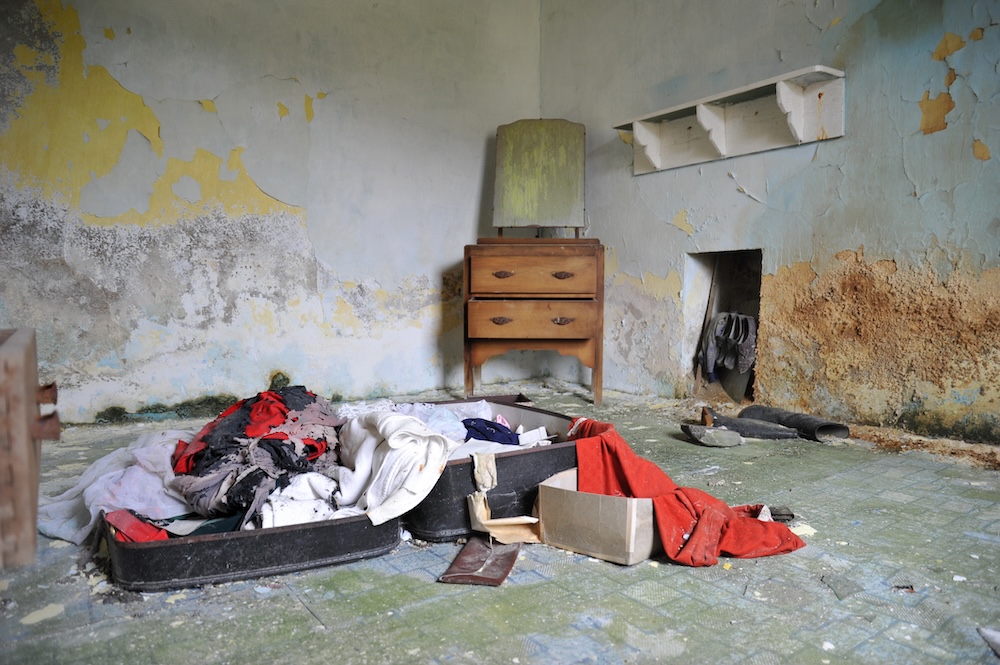
The edition makes me think of writer Darran Anderson in his interview with artist Sapphire Goss (in the Yale Review) about how we find ruins compelling. He says ‘I used to think the attraction to ruins was a morbid fascination with the darkness of the past, but now I’m starting to think perhaps it’s the opposite. Perhaps it’s actually a comfort, something that helps me orient myself in this vast ocean of time. Or maybe I feel some kind of misanthropic reassurance in thinking that all this too will one day be ruins — that the world will finally have its revenge on us’. And also, perhaps how John Cale as a musician explores sound and silence and our relationship between vacancy and feeling. What do you think as an artist, aside from the personal connection, drew you back to these abandoned spaces aesthetically?
I do agree with aspects of Darran Anderson’s perspectives on ruins. There was a sort of a comfort alongside the poignancy in revisiting these places and finding the remnants of people’s lives. Some of the hearths I had visited a very long time ago when all was well and the residents were alive. Because of the way many of the cottages had been left with personal belongings just lying around — as if the owner had just walked that moment out of their life without looking back — one had a real sense of who had lived there. The other aspect that drew me to the abandoned cottages was the beauty of the layers of time that could be seen — the colours of the flaking paint, rotting furniture, bursting straw mattresses. I found all that very exciting visually.
Hearths are often entry points or portals, places where we place personal objects of importance and where we gather where families are held together, and bonds are created. By publishing this essay and images, has it created a sense of completing a circle for you?
Yes, there is a sense of completing a circle in some way — but also finding a way of expressing and recording my childhood experiences in a tangible and meaningful way, and one that is entirely my own.
*
Read Kate’s introductory essay to ‘Twenty Six Achill Hearths’, as included in the edition, below.
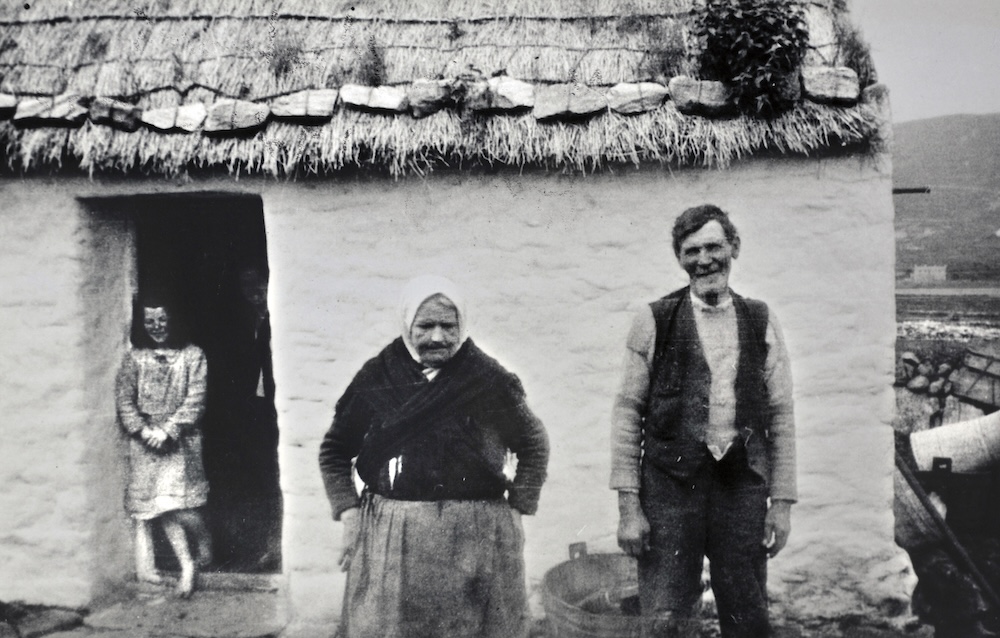
Here are my grandmother’s sister Mary Cooney (1864-1947) and her husband Frank Molloy (b.1862) outside their home on Achill Island in the 1930s. Mary Cooney cared for my grandmother Peggy (b.1881) and her two other sisters, Sally and Julia, after their parents died from influenza during the pandemic of 1889. Their older siblings Joseph (18), Nancy (20) and Martin Cooney (15) drowned in 1894 when a hooker carrying them to the ship they were to sail on to Scotland for the annual potato harvest capsized in Westport Harbour. I dedicate these pages to all my Achill ancestors and living relatives among the Cooney, Gallagher and Masterson families — especially to those who looked after me as a ten-year-old and introduced me to the heart of island life.
In 1960, I travelled across Ireland to Achill Island with my grandmother. She was 80, I was barely ten. Every year she would take a grandchild ‘home’ with her, to introduce us one by one to the old life and our outlandish Irish relatives. She also liked to have an extra pair of small hands to help her with her luggage and the other practicalities of the journey. Her name was Margaret Cooney; she was born on Achill in 1881 and there married Peter Gallagher, another islander, who came to England as an aide to the Irish Nationalist MP Robert Ambrose. Four of their children were born on Achill; two more, including my mother, in East London. I was one of their 15 grandchildren.
Until then, I had never been away from home without my parents. The travelling by ferry boat, train and car was terribly long and has since become a blur (except that I remember clearly that on the return journey we smuggled two whole chickens through Customs in milk tins). Whenever my grandmother needed help along the way, she became a different person. There was suddenly much flattery and pleading and ‘God-be-with-you’ blarney, and her eyes would go teary on cue. I had never spent any time on my own with her before. Whenever she stayed with us, she just sat in an armchair and slept, so I was surprised to see her so much in control and so cleverly manipulative.
The ferry took us to Dublin and the train from there the following day to Westport, County Mayo, where we were collected by car — one of very few out there — and driven into the summer’s night. No streetlights, only darkness.
The first thing I noticed was a smell of burning — not altogether unpleasant, but very unfamiliar. I was shown inside a small cottage — no hallway or porch, seemingly just one room, very dimly lit, busy with people who were sitting in a huddle or standing against the walls. I was very tired and already missing home, and now dismayed to find myself somewhere alien and dark. No-one had told me that it would be quite so different from the bungalow in Bognor Regis where I lived in those days.
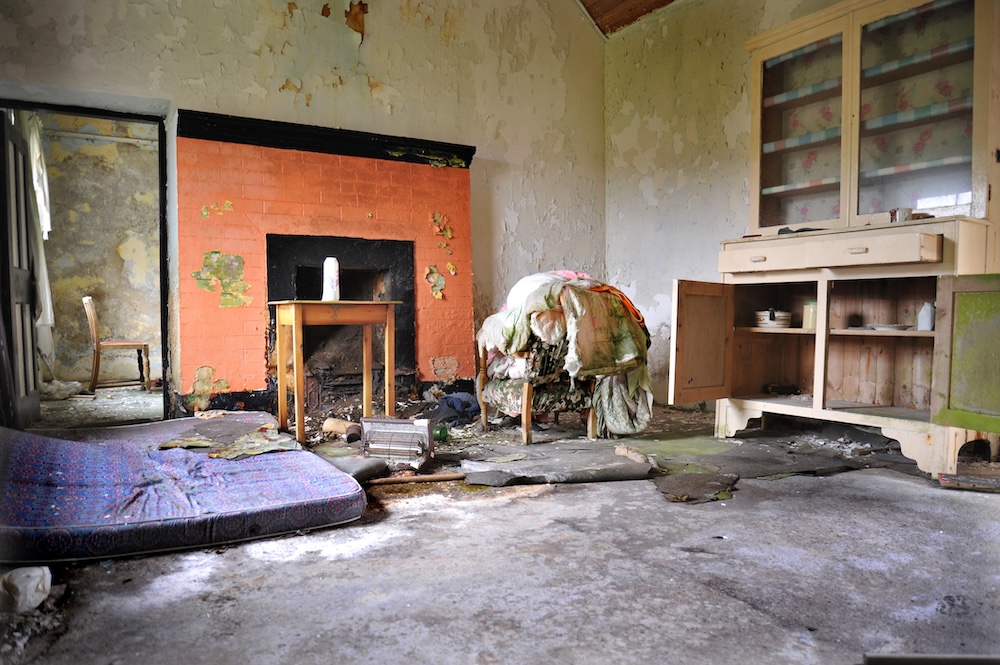
Everyone looked old to me — women mostly, all wearing headscarves and dressed in dark shabby clothes. There were so few men because the husbands and fathers were away working in England or Scotland, which was the normal summer routine for them. They greeted my grandmother ‘Peggy’ warmly and I was introduced to each of them. There was lots of lip-kissing and tears. They squeezed my hands and stroked my face and hair and spoke kindly to me, but I couldn’t understand an Irish or an English word. In the wall to my left was an open hearth and a smouldering fire, and it was from there that the strange smoky-sweet smell was drifting — from the burning turf.
The hearth was the true heart of the house. The turf fire was always burning, even in summer. Kettles were kept hot on it, potatoes were boiled and stews stewed. At the time, I had no idea where the turf came from. Walking the peat bogs years later, I saw the new channels being cut in spring and came to understand how every piece put on the fire had already been handled several times by the families who dug their quota from the bog — once in the cutting, then in the footing, again in the drying and the bagging up, again in the ‘clamp’ building. Achill turf clamps were once constructed with the same obsessive care as Norwegian wood stacks. I used to travel back to England with a few sods of turf in my luggage for comfort — to burn in winter to remind me of the pungent fragrance of Achill fires.
In more recent years, since the Celtic tiger came and went and the house-building across the western counties boomed and bust, I’ve been photographing abandoned cottages more or less like the one I first encountered as a child and where my grandmother and I shared a bed. I clamber into them through broken doors or over fallen lintels, and photograph whatever I find, always focusing on the cold, empty hearth.
Some of the cottages have lain ruinous for decades, others have been left somehow frozen — as if the last inhabitants stepped out one day never to return, leaving behind all their belongings to be reduced to the earth — clothes hanging up, teapot and cups on a table, a suitcase hastily packed… It still happens occasionally: there are inheritance disputes; people die in solitude on Achill, their relatives long lost to them on the other side of the world. In a few cases, I’ll have known the vanished inhabitants, or will have been revisiting an address for the first time since my grandmother took me to it sixty years before. And the experience is always palpably nostalgic. It induces a visceral sensation of return — always the small, squarish fireplace opening in the wall to the left or right on entering. It is often no more than a simple, unadorned recess, but sometimes I’ll discover the remnant of an attempt to enshrine the hearth and to decorate it with tiling, mosaics, wooden surrounds and mainland suburban mantelpieces. I find these remnants of domestic devotion the most affecting — keeping in mind the dark storm so often roaring outside.
That first journey to Ireland and to Achill as a child made a very deep impression on me. I think the memory has remained so vivid all my life because at the time no one explained anything to me. To the islanders — and to my grandmother also — the significance of everything in their everyday surroundings was self-evident; to me it was an unfathomable mystery. In those days on the island, children weren’t made a fuss of. Generally, they were left to their own devices. I suppose I continue to be childlike in my enjoyment whenever I’m there, sneaking about like this, alone with my camera. And now I feel strangely compelled to uncover these forsaken places — along with the associations and sensations they trigger in me — before all of them disappear.
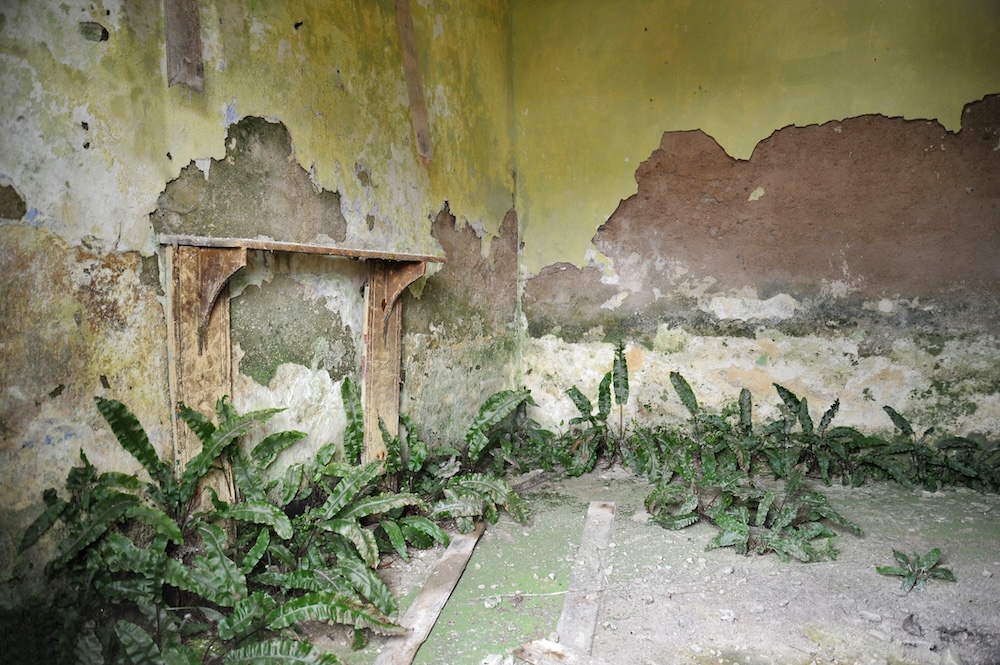
*
You can contact Kate via her website or Instagram to enquire about purchase or display of ‘Twenty Six Achill Hearths’.